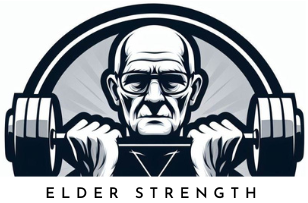Welcome friend! In this post, you will learn how many steps per day for seniors is a good goal and why you should try to get your steps in every day.
I’m sure you’ve come across health articles about the importance of getting several thousand steps a day. Or maybe your physician has recommended monitoring your step count.
Steps are essentially a crude meter for your overall activity that day. They don’t tell how much effort you put in to achieve those steps, but a high step count will always tell that you’ve been active one way or another.
Step count has been researched extensively and there is an abundance of evidence for the health benefits of an active lifestyle.
We live in a very sedentary world these days where it’s possible to live your life without taking more than a few hundred steps per day, or even a week.
You can get your food delivered, you can transport yourself with a car that’s parked on your doorstep, most work is done on a computer, you can get all the entertainment you need with a push of a button, etc. The list goes on and on.
This means that you essentially have to either intentionally choose to exercise or choose activities that require you to move around on your own feet.
But the truth is that even then it’s very easy to end up spending most of your days being sedentary if you don’t have systems in place to monitor your activity levels.
This is where counting steps come in.
Why Steps Are Important
So what’s the big deal with counting steps? Steps are a great way to monitor your overall activity levels, which are correlated with positive health outcomes.
Regular activity is associated with reduced risk of heart disease, hypertension, diabetes, obesity, depression, and certain cancers. And it helps control your weight. In short, being active is healthy.
The truth is that you (and everyone else) are very bad at estimating their overall activity level. If you don’t have some kind of measure for it, it’s very easy to fool yourself into believing you’ve been active.
After all, it can feel like you’ve been very active if you’ve been reading or thinking a lot, socializing, watching something exciting, eating, drinking alcohol, etc.
These can expend your mental energy and make you content or even exhausted. But they do not offer the health benefits of physical activity.
Your step count will show walks with the dog, strolling in the park, cleaning, gardening, and home improvement, jogging and power walks, playing with the grandchildren, shopping, etc. And walking is a great form of exercise for seniors.

This will help you monitor and increase your activity levels if need be. Studies have shown that people who monitor their step count get on average 2,500 daily steps more than people who don’t. This will likely offer significant long-term health benefits.
There are of course some shortcomings in only monitoring your steps. Let’s say you do a lot of cycling or rowing but don’t like to walk much.
This would lead to a reduced step count even though you might be actually very fit, the activities just don’t show on your pedometer as steps.
That said, short-duration intense exercise is no substitute for overall activity. Optimally you should include both in your lifestyle.
How To Count Steps
So how do you count steps? Well, you just pay attention to each step you take and try your best to remember the number throughout the day. It gets easier over time.
I’m kidding of course! The only reasonable way to count steps is to use technology as our assistance.
Not long ago people used dedicated pedometers to count steps but these days most people, including seniors, have some form of smart device that has a free pedometer built into them.
Virtually any smartphone, activity bracelet, or smartwatch will have a step counter in them. On smartphones, you usually have to install a health app like Google Fit to access it.
But that’s all there’s to it. Of course, you have to keep your smart device on you the whole day for it to register steps but other than that you can just set it up and forget about it.
I personally find fitness trackers as the most convenient way to monitor my steps because I use them as a watch that’s on my wrist constantly.
They are a bit more durable and cheaper than actual smartwatches so I don’t have to worry about breaking expensive devices during activities.
One thing that is important to know about step counting is that there are differences between devices, some are more sensitive than others.
Smart devices can also think that activities that involve shaking your hands are steps because they cause the sensors to register movements. The devices have pretty good at recognizing them, fortunately.
But all this doesn’t really matter because the most important part is to get the general ballpark of your daily activity so you can set goals and monitor it long term.
Recommended Amount Of Steps For Seniors
So what’s the recommended amount of daily steps for seniors? Well, there isn’t one size fits all answer to that.
Your daily step goals is highly dependent on your physical health and fitness. Someone who is significantly overweight and mostly sedentary is very different from someone who’s very athletic not to mention people with heart disease for example.
Of course your age can matter a lot. “Seniors” is a very large age group ranging from around 65 to 100+ years old. It’s not reasonable to expect a similar amount of steps for someone who is 65 than for someone who is 95.
That said, seniors should aim to be active and walk daily to maintain good health, regardless of age. If you are healthy and normal weight, this 2011 study is a good starting point.
It concluded that the daily public health exercise recommendations in healthy older adults is equivalent to 7,000 to 10,000 daily steps.
The study also concluded that disabilities and chronic illness will affect the estimates of recommended daily physical activity.
If you do have disabilities, chronic illness or are it’s important to plan your activity levels with your healthcare provider. 10,000 steps take quite a bit of effort and can cause too much stress on your body if your health is compromised.
Consistency Is More Important Than Amount
Finally, I want to mention the importance of consistency and routine in your activity levels.
Exercise is something that you should do daily in some form. It doesn’t have to be strenuous exercise like going to the gym, but you should aim to at least do a short walk daily.
If you are sedentary for most of the week and then go do vigorous exercise for an hour, you will likely not reap all the long-term benefits of an active lifestyle.
Or even worse, do the intense or long-duration exercise once or twice a month and then be sedentary the rest of the time.
This type of exercise routine can be dangerous as you get older as your cardiovascular system might not be able to adapt to the sudden increase of demand every couple of weeks.
Remember that exercise causes positive stress on your body and when your rest, your body will adapt by becoming a bit stronger or endurable so it can perform better the next time.
But these adaptations will diminish quite fast when you stop exercising. So it’s better to get a bit of exercise every day or several times a week to keep up the adaptations.
This is why consistent, regular exercise is more important than doing vigorous workouts every now and then.
If you are not very active currently and are trying to increase your activity levels, don’t stress too much about duration and amount in the beginning.
Focus on taking a short walk once or twice a day, make it enjoyable. This way it will turn into a routine in a few weeks and you can slowly start increasing the duration as you find the activity more enjoyable.
Any exercise is better than no exercise.
Conclusion
That concludes our post about step count. I hope you learned how many steps for seniors per day is a good goal.
If any questions popper into your mind, you can leave them in the comments section below and I will do my best to answer you.
As a recap, step count is a great way to monitor your overall activity levels. They are not an exact measure, so it’s more important to focus on the bigger picture and trends.
A good goal for healthy and normal weight seniors is 7,000 to 10,000 steps but it’s always wise to start slowly and build up as you go so your body has time to adapt.
Remember that a consistent routine of regular exercise is more important than random vigorous exercise or fixating on numbers.
And remember that the most important thing is to make exercise enjoyable!


I am 76 and have osteoarthritis in Mt right hip and left knee. I am currently walking around 3000 steps per day because that’s all I can manage. Is that sufficient for my age? My Fitbit analysis tells me that my heart is very healthy for my age.
It’s great to hear you’ve kept active even with your health problems Iris! I can’t give you advice on the step count as that is something you should discuss with your doctor. Generally speaking any amount of activity that doesn’t significantly aggravate your symptoms is likely more beneficial than being sedentary. But with any type of arthritis it’s important you plan your activity levels according to your treatment plan. Hope this helps and keep up the good work!